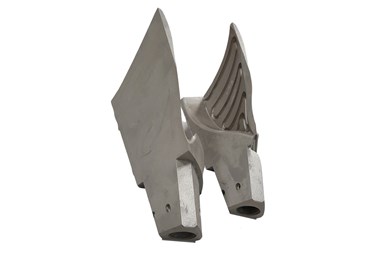Shaping Steel Enables More Complex, Efficient Injection Molds
AddUp’s AISI 420 stainless steel is commonly used to manufacture molds for plastic injection molding, as it has high mechanical strength and good corrosion resistance.
AddUp Inc.’s shaping AISI 420 steel is commonly used in the field of plastic injection and can now be used for additive manufacturing (AM). The company says AISI 420 steel can enable tooling manufacturers to develop new, more complex and more efficient molds. The material is now available for all FormUp 350 new generation powder bed fusion (PBF) machines.
AddUp, a joint venture created by Michelin and Fives, says it is one of the first players in the metal 3D printing sector to offer a recipe for implementing AISI 420 steel. Also referred to in the German standard as 1.4021 or 1.2083, this stainless steel is commonly used to manufacture molds for plastic injection molding, as it has both high mechanical strength and good corrosion resistance.
This development for AISI 420 adds to its broad portfolio of materials for the tooling sector, including 316L stainless steel and Maraging 300 (M300) steel. The company says the shaping AISI 420 steel is compatible with existing postprocessing solutions.
“Unlike alloys specially designed for additive manufacturing, which require users to invest in developing suitable postprocessing, we offer here a widely used grade,” says Frédéric Sar, AddUp materials manager. “With AISI 420, the post-printing operations are identical to those of parts produced by forging. Existing solutions in heat treatments, surface treatments, machining settings and insert grades are directly applicable to printed parts.”
Thus, manufacturers have a wide range of treatments at their disposal, enabling them to target specific properties for each application. For example, the “quenching/tempering”-type heat treatments already available for raw 420 steel enable printed parts to display tensile strength characteristics in the range of 1,350 to 1,980 MPa, with elongation at break values of 2 to 10%, depending on the tempering temperature. And, standard surface treatments (such as nitriding) can significantly increase the surface hardness of parts after machining. Finally, the AISI 420 alloy does not contain cobalt or nickel, making it compatible with the requirements of the REACH directive.
Related Content
-
Treatment and Disposal of Used Metalworking Fluids
With greater emphasis on fluid longevity and fluid recycling, it is important to remember that water-based metalworking fluids are “consumable” and have a finite life.
-
How to Eliminate Chatter
Here are techniques commonly used to combat chatter and guidelines to establish a foundation for optimizing the moldmaking process.
-
It Starts With the Part: A Plastic Part Checklist Ensures Good Mold Design
All successful mold build projects start with examining the part to be molded to ensure it is moldable and will meet the customers' production objectives.
















